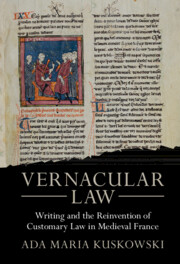Book contents
- Vernacular Law
- Studies In Legal History
- Vernacular Law
- Copyright page
- Dedication
- Contents
- Figures
- Acknowledgments
- A Note on the Text
- Introduction Vernacular Writing and the Transformation of Customary Law in Medieval France
- Part I Written Custom and the Formation of Vernacular Law
- Part II Political and Intellectual Tensions
- Part III Implications
- 6 Custom in Lawbooks and Records of Legal Practice
- 7 Dynamic Text: Dialectic, Manuscript Culture, and Customary Law
- 8 Implications of Circulating Text: Crafting a French Common Law
- Conclusion Lasting Model and Professional Community
- Bibliography
- Index
8 - Implications of Circulating Text: Crafting a French Common Law
from Part III - Implications
Published online by Cambridge University Press: 27 October 2022
- Vernacular Law
- Studies In Legal History
- Vernacular Law
- Copyright page
- Dedication
- Contents
- Figures
- Acknowledgments
- A Note on the Text
- Introduction Vernacular Writing and the Transformation of Customary Law in Medieval France
- Part I Written Custom and the Formation of Vernacular Law
- Part II Political and Intellectual Tensions
- Part III Implications
- 6 Custom in Lawbooks and Records of Legal Practice
- 7 Dynamic Text: Dialectic, Manuscript Culture, and Customary Law
- 8 Implications of Circulating Text: Crafting a French Common Law
- Conclusion Lasting Model and Professional Community
- Bibliography
- Index
Summary
The eighth and final chapter examines the larger effects of textualization and vernacularization. The combination of the new technology of writing with the social choice of the vernacular permitted ideas about custom to circulate beyond their traditional local community ambit. Previously rooted laws and customs grew legs, and customary legal ideas could be transmitted though the circulation of texts and shared outside their local setting. In fact, this is when we start seeing the term ‘common law’ appear in French texts, a term scholars associate in this period with either royal law in England or with Roman and canon law as law that was common to Europe. This French ‘common law’ has been hotly debated. This chapter contributes to this debate by using the coutumiers to show how a French ‘common law,’ in the sense of a pool of common customary legal knowledge, was developing in France. This, in turn, implies more similarity between the legal cultures of France and England in this period than previously thought.
Keywords
- Type
- Chapter
- Information
- Vernacular LawWriting and the Reinvention of Customary Law in Medieval France, pp. 315 - 347Publisher: Cambridge University PressPrint publication year: 2022

